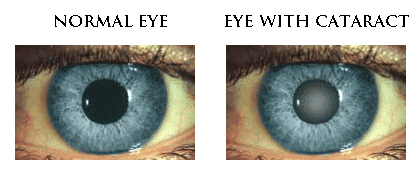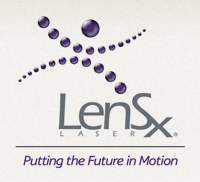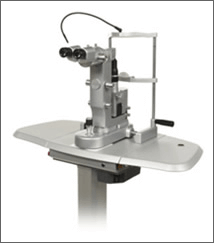What is a Cataract?

- A cataract is a yellowish clouding over the lens of the eye which grows thicker and harder over time.
- This can eventually lead to blurry, distorted vision and other difficulty seeing.
- Cataracts are a very common eye condition that can occur in one or both eyes.
- Most cataracts progress with age.
- Age-related cataracts usually develop slowly in adults over age 40.
- More than 90% of Americans begin to develop cataracts by age 65.
- Fortunately, most cataracts can be successfully treated with a simple, painless surgery.
- More than 98% of patients report better vision after cataract surgery.
- With advanced technology, patients can often reduce their dependence on glasses and enjoy clear vision for years to come.
How Do Cataracts Affect Vision?
- The yellowish clouding of a cataract eventually affects the clarity of vision. (The lens of a healthy eye is normally clear with a flexible, jelly-like consistency.)
- This can eventually lead to blurry, distorted vision and other difficulty seeing. (For clear vision, light needs to pass through the transparent lens to the retina.)
How Can I Tell if I Have a Cataract?
Only an eye doctor can diagnose whether you have a cataract or another type of vision problem. If you have any of the symptoms below, schedule a comprehensive eye examination with a specialist at Middlesex Eye Physicians in Middletown or Westbrook, CT.
- Gradual increase in blurriness of vision
- Trouble driving at night
- Halos around bright lights at night
- Glare from headlights or sunlight is increasingly troubling
- Difficulty reading
- White objects may appear yellowed
- Bright colors appear faded
Surgery is the Only Treatment Option for a Cataract
- There are no medications or medical devices for treating cataracts.
- Cataract surgery is a simple outpatient procedure that takes less than a half hour.
- There have been incredible advances in cataract surgery techniques over the past two decades.
- Millions of people every year have cataract surgery.
- Most of them have a positive experience with no complications and a great visual outcome.
What Is ADVANCED TECHNOLOGY in Cataract Treatment?
- When a cataract is removed, it is replaced with an intraocular lens (IOL).
- Most IOLs are monofocal and may require a person to wear glasses after surgery.
- We now have Advanced Technology IOLs (ATIOLs), which can markedly reduce spectacle dependence, for both distance and near, as well as correct astigmatism.
- In addition, some surgeons use a laser-assisted method of cataract surgery (Lensx).
- Insurance typically covers cataract surgery itself. There may be an out-of-pocket expense associated with some of the advanced technology options.
- Discuss the best surgical and lens options with your ophthalmologist.
TORIC LENS
The Toric Lens corrects the astigmatism in a patient’s eyes by reshaping the way light enters through the cornea. The Toric Lens will either replace your prescription glasses or reduce glasses dependence.
EXTENDED DEPTH OF FOCUS IOL
The Extended Depth of Focus IOL Lens corrects vision so that a patient has distance, intermediate and some functional near vision. This means vision for driving, computer type work and some reading with reduced glasses dependency.
MULTI-FOCAL IOL
The Multifocal IOL Lens has a series of rings that work with light and your pupil to enhance vision for distance, intermediate and near. This means clear vision and reduction in spectacle dependency.
Patient Testimonials
Tracey
John
Bill
What is Laser-Assisted Cataract Surgery?

- The major difference between traditional and laser-assisted cataract surgery is that incisions are made by a programmed laser rather than by a surgeon using a scalpel.
- The LenSx®, Femtosecond Laser used by Middlesex Eye surgeons offers real-time diagnostic tools, as well as, greater control and precision.
- This is only available at Hartford Hospital Surgical Center in Newington, CT.
- Middlesex Eye Physicians is pleased to offer the LenSx® Laser to their cataract patients. The laser allows our physicians increased precision with laser pulses that create the incisions and real-time diagnostics.
- With LenSx®, our surgeons have the ability to see your eye’s actual anatomy.
- Like fingerprints, every eye has a different anatomy in relation to size, shape, curvature, lens position, and visual acuity, which the LenSx® technology reads.
- This leads to better results for patients and quicker healing.
Does Insurance Pay for Cataract Surgery?
- Most insurances including Medicare pay for cataract surgery with a monofocal IOL.
- Every insurance plan has different policies, co-pays, and deductibles.
- It is suggested that you call your insurance company to understand your benefits. Our doctors have affiliations with both and ambulatory facility and a hospital out-patent facility.
- Prior-authorizations are taken care of by the surgical coordinators after the doctor has determined the need for surgery and you have your surgeries planned.
- Remember advanced technology lenses incur an additional cost beyond what insurance will pay. We encourage you to use Care Credit so that you can fulfill your vision goals and decrease spectacle dependency.
What Are the Possible Complications of Cataract Surgery?
- No surgery is risk-free, but the risk of complications with cataract surgery is very low.
- Possible complications include infection, swelling, headache and bleeding, however these are rare.
- Your cataract surgeon at Middlesex Eye Physicians will review the possible complications with you before you consent to surgery.
Post Cataract YAG Laser

- Sometimes after cataract surgery a thin membrane develops behind the intraocular lens implant.
- This common post operative condition is called posterior capsule opacity.
- This is not a new cataract and can easily be dissolved with the aid of a YAG laser.
- If you get blurry vision after cataract surgery, even years later, make an appointment to discuss this with your Middlesex Eye Physician surgeon.
Treating Posterior Capsule Opacity with a YAG Laser
A YAG laser can treat posterior capsule opacity safely, effectively and painlessly. This procedure, known as YAG laser capsulotomy, is performed in the Middlesex Eye Physicians’ office as an outpatient procedure.
YAG laser capsulotomy involves just a few simple steps:
- Dilation of the eye is done with eye drops.
- A laser removes the hazy posterior capsule from your line of sight without making an incision or touching the eye.
- Drops may be given after the procedure to reduce inflammation.
- The procedure takes only a few minutes and is painless.
- Following a YAG laser capsulotomy, patients may resume normal activities immediately.
- There is a possibility that patients may experience floaters (or spots in vision) after the procedure. These will likely resolve within a few weeks.
- Most people can expect their vision to improve within a day.
- As with any eye procedure, however, call your eye doctor immediately if vision worsens or fails to improve.
YAG Laser Capsulotomy Risks
- Although a YAG laser capsulotomy poses slight additional risks, overall the procedure is extremely safe.
- The most important risk is that the retina can become detached from the inner back of the eye. This complication is rare, with or without the laser procedure.
- Statistics suggest that the lifetime risk of a detached retina after cataract surgery is about 1 percent.
- That number rises to about 2% after YAG laser capsulotomy.
- It is important to be aware of these risks and notify your doctor if you notice any new flashing lights or floaters.
Schedule Your Cataract Evaluation Today!
To schedule a cataract evaluation, contact your local Middlesex Eye Physician’s office in Middletown or Westbrook, CT. You will be amazed at how much your vision improves with cataract surgery!

